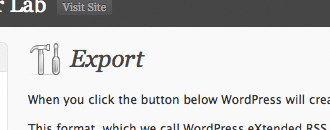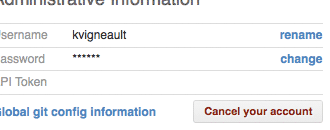The 3 Rules to Breaking Up
If you accept sign ups for your website, there will inevitably come a time when some of your users no longer desire to use their accounts. Sometimes, this is because they've moved on with their lives and don't need your services anymore. Other times, it might be because they've found someone else. No matter what the reason, the way in which you handle the break up can be the difference between an angry tweet and a recommendation to a friend; afterall, you're likely not going to know why they left in the first place. The following three rules will hopefully give you some guidance for how your website might handle breakup situations in the future.
-
Rule #1: Let them retrieve their data
In the words of the faux boy band, 2gether, "The hardest part of breaking up is getting back your stuff." If your website allows people to publish podcasts, manage photos, create contact lists, store bookmarks, etc., it's a good idea to provide a method for bulk exporting this content into a format that can reused. For example, Wordpress provides an export feature that generates an XML file with all blog content - posts, tags, categories, etc. This XML file can be imported into other blogging platforms.

-
Rule #2: Provide a way to cancel or delete accounts
Having lingering accounts floating around the web with names and email addresses potentially associated can be worrisome to certain people. While you could argue that changing a username and email address is effectively the same as deleting an account, to me, there's a pleasant feeling associated with deleting an account I'm no longer using - like I picked up after myself. This is especially true in cases where I've inadvertantly created multiple accounts on the same site. As an example, I once had multiple accounts on GitHub and was pleased to discover how easily they allowed me to Cancel my account. The process involved two clicks with no questions asked and I appreciated them for it.

-
Rule #3: Don't call or write
Once I've signaled to a website that I no longer want to use my account by either deleting the account or becoming inactive, I really don't want to receive emails asking me why I left or trying to entice me to come back (a confirmation email after an account is deleted is obviously fine.) Some may disagree with this one and argue that it's good follow-up marketing to send out an email after a user has gone inactive for a certain period of time. I disagree. While it might be possible to lure a small percentage of former visitors back to your site by following up with them down the road, you're likely annoying a larger number of people (some of whom may still be using your website through a different account) with un-solicited emails.
In the end, if someone wants to stop using your website, there's nothing you can do about it - and that's okay. Give people a nice experience on their way out and there's a better chance they'll come back to you if they do in fact need your website again in the future. Even more importantly, if you you see a trend of users becoming inactive or deleting their accounts, find out why and improve your website.
